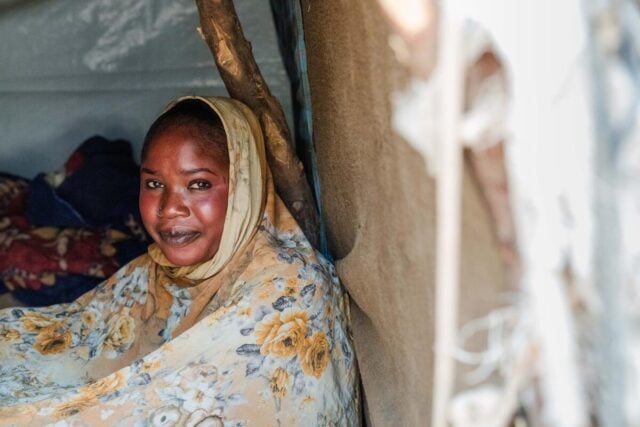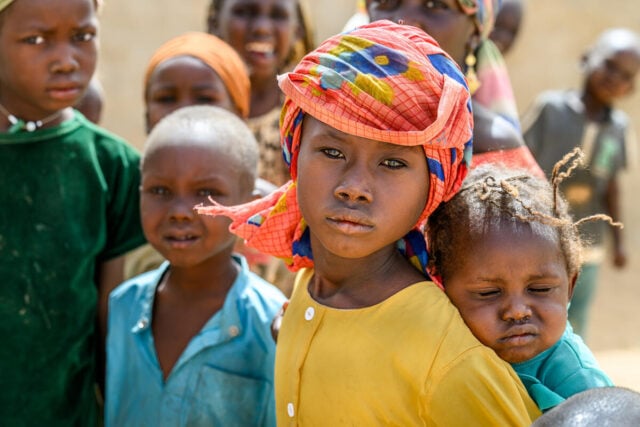
Disaster Relief
World Vision’s presence in nearly 100 countries enables us to quickly provide immediate support in all types of disasters and humanitarian crises — and we are committed to long-term support, staying to help children, families, and communities recover and rebuild.
For over 75 years, motivated by our Christian faith and empowered by generous donors, we’ve rushed in to save lives, reduce suffering, and restore hope. As the World Food Programme’s largest distribution partner, we’re able to scale our response and reach those most in need with speed and efficiency. In 2024 alone, World Vision responded to 84 disasters and humanitarian emergencies across 65 countries.
84 disasters
In 2024, World Vision responded to 84 disasters in 65 countries.
35 million people
We reached over 35 million people with critical aid including emergency food and healthcare; clean water, sanitation, and hygiene solutions; child protection; and much more.
2 million people
Since April 2023, 2 million people, including 1,518,452 children, have been reached with aid in response to the hunger crisis in Sudan, South Sudan, Chad, and the Central African Republic.
Our Disaster Response Approach
How quickly does World Vision respond to a disaster, and what is your immediate response?
When disaster strikes, World Vision adopts a “first-in, last-out” approach: We first respond with life-saving emergency aid, and then we stay for the long term to help families recover and rebuild.
- Within the first couple of hours after a disaster, World Vision staff members closest to the disaster respond with reports on the level of severity and need.
- Within 24 to 72 hours of the disaster, our global rapid response team is on the ground, making assessments and beginning to provide emergency relief.
- Within 72 hours of the disaster, our pre-positioned relief supplies are loaded up, transported, and distributed from local and international warehouses.
- For the first week, we continuously distribute emergency aid and relief to residents affected by the disaster.
Over the following month, we work to help families stabilize by providing assistance with temporary shelter, water, sanitation and hygiene, child protection activities, healthcare, and economic opportunities.
How do you help residents recover from the trauma of disaster over the long term?
We are quick to respond to disasters, but we also focus on helping to rebuild the lives of disaster-affected families and communities over the long term. Large-scale disasters often leave hundreds of thousands of people homeless and vulnerable.
While emergency relief is necessary and saves lives, it is not enough. We help disaster survivors by assisting their transition from relief mode to recovery and rebuilding mode. This recovery and rebuilding phase involves a transition to permanent housing, clean water, sustainable sources of food, access to education, and re-established livelihoods.
When disaster strikes, which World Vision employees respond?
World Vision’s Global Rapid Response Team brings together international disaster experts from around the world, who are deployed within hours of a major emergency to support local teams and communities. The global rapid response team includes relief managers, program officers, and specialists in health and nutrition, human resources, finance, logistics, security, food aid, child protection, information technology, and communications — all working as a team to provide effective emergency relief.
In a large-scale response, World Vision collaborates with the United Nations and other local aid agencies. This collaboration helps avoid duplication, maximize efficiencies, ensure all needs are met, and eliminate gaps in humanitarian response.
How do you prepare to make sure you’re ready when an emergency occurs?
Having a disaster response fund ready to use, pre-positioning supplies like non-food items, and having staff prepared and trained to respond to emergencies is increasingly important to how we respond to disasters.
The global pre-positioning resource network is our designated team that makes sure we’re prepared to respond rapidly to any disaster anywhere in the world. The team pre-positions the supplies and develops preparedness plans, programming standards, logistic assessments, and logistic plans.
The supplies are ready to go in seven different warehouses that are strategically located all around the world. These relief supplies are ready for up to 225,000 beneficiaries at any time, ensuring that those affected by disasters will have emergency supplies distributed to them quickly and efficiently.
Disaster Response Resources
U.S. Disasters Report Summary:
In FY24, World Vision responded to 15 U.S. disasters, delivering critical relief and long-term recovery support to over 52,000 people, helping communities rebuild and regain hope.
Sudan Crisis Response Summary:
Since the outbreak of conflict in Sudan in 2023, World Vision has reached over 2.8 million people, including 1.5 million children, with life-saving food, clean water, healthcare, and protection, responding to the world’s largest displacement and hunger crises.
World Vision’s presence in nearly 100 countries enables us to quickly provide immediate support in all types of disasters and humanitarian crises — and we are committed to long-term support, staying to help children, families, and communities recover and rebuild.
84 disasters
In 2024, World Vision responded to 84 disasters in 65 countries.
35 million people
We reached over 35 million people with critical aid including emergency food and healthcare; clean water, sanitation, and hygiene solutions; child protection; and much more.
2 million people
Since April 2023, 2 million people, including 1,518,452 children, have been reached with aid in response to the hunger crisis in Sudan, South Sudan, Chad, and the Central African Republic.
Our Disaster Response Approach
How quickly does World Vision respond to a disaster, and what is your immediate response?
When disaster strikes, World Vision adopts a “first-in, last-out” approach: We first respond with life-saving emergency aid, and then we stay for the long term to help families recover and rebuild.
- Within the first couple of hours after a disaster, World Vision staff members closest to the disaster respond with reports on the level of severity and need.
- Within 24 to 72 hours of the disaster, our global rapid response team is on the ground, making assessments and beginning to provide emergency relief.
- Within 72 hours of the disaster, our pre-positioned relief supplies are loaded up, transported, and distributed from local and international warehouses.
- For the first week, we continuously distribute emergency aid and relief to residents affected by the disaster.
Over the following month, we work to help families stabilize by providing assistance with temporary shelter, water, sanitation and hygiene, child protection activities, healthcare, and economic opportunities.
How do you help residents recover from the trauma of disaster over the long term?
We are quick to respond to disasters, but we also focus on helping to rebuild the lives of disaster-affected families and communities over the long term. Large-scale disasters often leave hundreds of thousands of people homeless and vulnerable.
While emergency relief is necessary and saves lives, it is not enough. We help disaster survivors by assisting their transition from relief mode to recovery and rebuilding mode. This recovery and rebuilding phase involves a transition to permanent housing, clean water, sustainable sources of food, access to education, and re-established livelihoods.
When disaster strikes, which World Vision employees respond?
World Vision’s Global Rapid Response Team brings together international disaster experts from around the world, who are deployed within hours of a major emergency to support local teams and communities. The global rapid response team includes relief managers, program officers, and specialists in health and nutrition, human resources, finance, logistics, security, food aid, child protection, information technology, and communications — all working as a team to provide effective emergency relief.
In a large-scale response, World Vision collaborates with the United Nations and other local aid agencies. This collaboration helps avoid duplication, maximize efficiencies, ensure all needs are met, and eliminate gaps in humanitarian response.
How do you prepare to make sure you’re ready when an emergency occurs?
Having a disaster response fund ready to use, pre-positioning supplies like non-food items, and having staff prepared and trained to respond to emergencies is increasingly important to how we respond to disasters.
The global pre-positioning resource network is our designated team that makes sure we’re prepared to respond rapidly to any disaster anywhere in the world. The team pre-positions the supplies and develops preparedness plans, programming standards, logistic assessments, and logistic plans.
The supplies are ready to go in seven different warehouses that are strategically located all around the world. These relief supplies are ready for up to 225,000 beneficiaries at any time, ensuring that those affected by disasters will have emergency supplies distributed to them quickly and efficiently.
Disaster Response Resources
U.S. Disasters Report Summary:
In FY24, World Vision responded to 15 U.S. disasters, delivering critical relief and long-term recovery support to over 52,000 people, helping communities rebuild and regain hope.
Sudan Crisis Response Summary:
Since the outbreak of conflict in Sudan in 2023, World Vision has reached over 2.8 million people, including 1.5 million children, with life-saving food, clean water, healthcare, and protection, responding to the world’s largest displacement and hunger crises.
Ways to Give to Disaster Relief
Disaster relief in the U.S.
World Vision is positioned and equipped to respond swiftly when disasters like hurricanes, tornadoes, and wildfires devastate communities across the United States. With a network of fully staffed and stocked warehouses and over 3,000 church and nonprofit partners, we’re often among the first to respond. We assess damage, identify urgent needs, and distribute critical relief and reconstruction supplies.
But our commitment doesn’t end with the immediate crisis. When communities need long-term support, we stay to help churches and families through the rebuilding phase, even after other organizations have left. Our deep local partnerships enable us to reach areas that are hardest hit and often overlooked, ensuring families get the support they need to recover and thrive.
Disaster Relief Fund
With decades of experience and an established network of global staff and pre-positioned resources, we respond to major emergencies worldwide quickly and effectively — and we stay to help rebuild lives for children, families, and communities.
Your support can help ensure rapid delivery of life-saving help and supplies, as well as long-term support to help vulnerable families recover. Thanks to donor contributions, combined with public grants from partnerships, every $1 you donate to the Disaster Relief Fund delivers $5 in impact.
Ways to Give to Disaster Relief
Disaster relief in the U.S.
World Vision is positioned and equipped to respond swiftly when disasters like hurricanes, tornadoes, and wildfires devastate communities across the United States. With a network of fully staffed and stocked warehouses and over 3,000 church and nonprofit partners, we’re often among the first to respond. We assess damage, identify urgent needs, and distribute critical relief and reconstruction supplies.
But our commitment doesn’t end with the immediate crisis. When communities need long-term support, we stay to help churches and families through the rebuilding phase, even after other organizations have left. Our deep local partnerships enable us to reach areas that are hardest hit and often overlooked, ensuring families get the support they need to recover and thrive.
Disaster Relief Fund
With decades of experience and an established network of global staff and pre-positioned resources, we respond to major emergencies worldwide quickly and effectively — and we stay to help rebuild lives for children, families, and communities.
Your support can help ensure rapid delivery of life-saving help and supplies, as well as long-term support to help vulnerable families recover. Thanks to donor contributions, combined with public grants from partnerships, every $1 you donate to the Disaster Relief Fund delivers $5 in impact.






